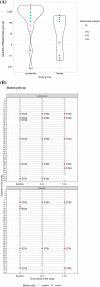Effects of Lactiplantibacillus plantarum and Lacticaseibacillus paracasei supplementation on the single-cell fecal parasitome in children with celiac disease autoimmunity: a randomized, double-blind placebo-controlled clinical trial
- PMID: 37946274
- PMCID: PMC10636941
- DOI: 10.1186/s13071-023-06027-1
Effects of Lactiplantibacillus plantarum and Lacticaseibacillus paracasei supplementation on the single-cell fecal parasitome in children with celiac disease autoimmunity: a randomized, double-blind placebo-controlled clinical trial
Abstract
Background: Lactiplantibacillus plantarum HEAL9 and Lacticaseibacillus paracasei 8700:2 positively affect the fecal bacteriome in children with celiac disease autoimmunity after 6 months of supplementation. The aim of the present investigation was to study the effects of Lactiplantibacillus plantarum HEAL9 and Lacticaseibacillus paracasei 8700:2 on the single-cell parasitome, with a primary focus on Blastocystis.
Methods: Stool samples were collected from 78 Swedish children with celiac disease autoimmunity participating in a randomized, double-blind, placebo-controlled clinical trial to either receive a mixture of supplementation with L. plantarum HEAL9 and L. paracasei 8700:2 (n = 38) or placebo (n = 40). A total of 227 stool samples collected at baseline and after 3 and 6 months of intervention, respectively, were retrospectively analyzed for Blastocystis by quantitative real-time PCR and subtyped by massively parallel amplicon sequencing. Other single-cell parasites were detected by untargeted 18S rDNA amplicon sequencing and verified by real-time PCR. The relation between the parasites and the bacteriome community was characterized by using 16S rDNA profiling of the V3-V4 region.
Results: Three different single-cell protists were identified, of which the highest prevalence was found for Dientamoeba fragilis (23.1%, 18/78 children), followed by Blastocystis (15.4%, 12/78) and Entamoeba spp. (2.6%, 2/78). The quantity of the protists was stable over time and not affected by probiotic intervention (P = 0.14 for Blastocystis, P = 0.10 for D. fragilis). The positivity of the protists was associated with increased bacteriome diversity (measured by multiple indices, P < 0.03). Bacterial composition was influenced by the presence of the protists: positivity of Blastocystis was inversely associated with Akkermansia (at the levels of the genus as well as its family, order, class and phylum); P < 0.002), Faecalibacterium (P = 0.003) and Romboutsia (P = 0.029); positivity of D. fragilis was inversely associated with families Enterobacteriaceae (P = 0.016) and Coriobacteriaceae (P = 0.022) and genera Flavonifractor (P < 0.001), Faecalibacterium (P = 0.009), Lachnoclostridium (P = 0.029), Ruminococcus (P < 0.001) and Granulicatella (P = 0.018).
Conclusions: The prevalence of single-cell protists is low in children with celiac disease autoimmunity. The colonization was stable regardless of the probiotic intervention and associated with increased diversity of the fecal bacteriome but inversely associated with some beneficial bacteria.
Keywords: Blastocystis; Celiac disease; Dientamoeba fragilis; Gut microbiome; Probiotics.
© 2023. The Author(s).
Conflict of interest statement
DA is an inventor in a patent application based on the results of the clinical trial but has signed over all legal rights to the patent to Probi AB. Probi AB has developed and supplied the study material (active and placebo products) for the trial as well as financially supported the trial with minor costs for analyzing material. None of the authors are employed by Probi AB and no salaries, consultancy fees, etc., have been paid by Probi AB to the authors in connection with the trial. The remaining authors declare that the research was conducted in the absence of any commercial or financial relationships that could be construed as a potential conflict of interest.
Figures




References
Publication types
MeSH terms
Substances
Grants and funding
- CZ.02.2.69/0.0/0.0/18_053/0016976/Charles University
- Programme EXCELES, ID Project No. LX22NPO5103/National Institute of Virology and Bacteriology
- Programme EXCELES, ID Project No. LX22NPO5103/National Institute of Virology and Bacteriology
- No 874864 HEDIMED/European Union's Horizon 2020 research and innovation programme
- No 874864 HEDIMED/European Union's Horizon 2020 research and innovation programme
LinkOut - more resources
Full Text Sources
Medical
Miscellaneous

